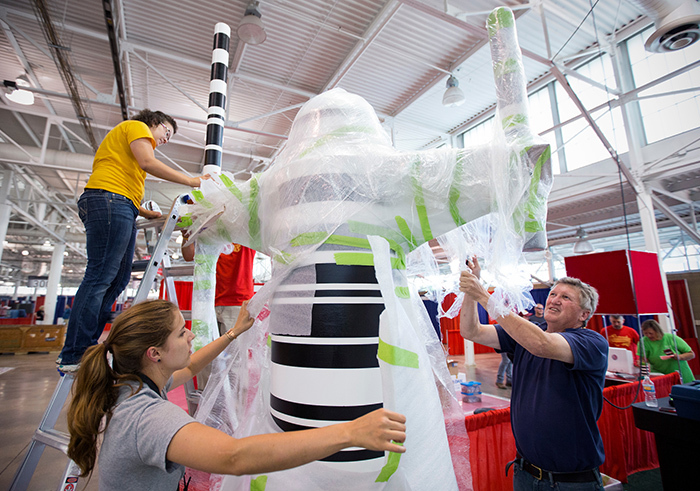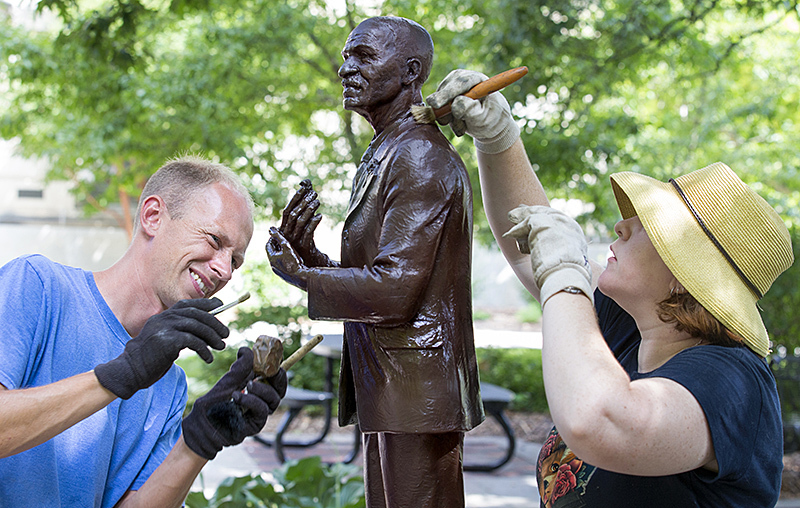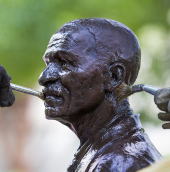First stop: State fair exhibit

Photo by Christopher Gannon.
Clockwise from right, Tom Stancliffe, Abby Hedley and Marie Glaser of the public art incubator at the University of Northern Iowa unwrap a refabricated G-Nome earlier this week at Iowa State's exhibit space on the state fairgrounds. One of four produced in aluminum by Stancliffe's team, the G-Nome joins seven other campus works of art in "Your Beautiful Adventure," the university's state fair exhibit, Aug. 11-21.
With its mates, next month it will replace the original terra cotta G-Nomes created by Minneapolis artist Andrew Leicester but damaged by 24 years in the elements atop the Molecular Biology Building. Like the originals, two of the refabricated G-Nomes have a domed head and two have a cylindrical head. At 400 pounds each, the metal versions are roughly half the weight -- but the same 12-foot height -- of the original G-Nome sculptures.
Lackey updates council on budget, salary issues
Tuition accounts for the "vast majority" of nearly $35.5 million in revenue growth in the FY17 general fund budget, chief financial officer and chief of staff Miles Lackey told the Professional and Scientific Council during its Aug. 4 meeting.
Tuition's share of that growth is about $33.8 million. Lackey attributed 57 percent of the tuition growth to enrollment increases and the other 43 percent to tuition increases.
State appropriations increased $2.2 million for the current fiscal year. The legislative request for Iowa State for this fiscal year was $8 million, and several iterations of tuition increases were implemented as a result of lower-than-anticipated state appropriations, Lackey said.
Still most affordable
Tuition hikes for the 2016-17 academic year include a $250 increase for resident undergraduates and a $694 increase for nonresident undergraduates.
Despite the increases, Iowa State's tuition and mandatory fees remain the most affordable among ISU's peer group (for both residents and nonresidents), Lackey said. However, he added that nonresidents are getting more sensitive to tuition increases and "that is something that we have to be mindful of."
Supplemental increases fund international services
Tuition increases this fall will include a $500 increase for all nonimmigrant, noncitizen international students. The increase is part of a three-year plan to fund expanded services for international students. Additional $500 increases will follow in the next two academic years.
The funds will help Iowa State better assist international students through, for example, prearrival and arrival services, writing and media center help, advisers in colleges and peer-to-peer programs, Lackey said.
Salaries
Faculty and staff compensation accounts for 66 percent of the incremental growth in this fiscal year's expenses. Lackey said the compensation increases were applied in these proportions:
- Two-thirds to current employees. Pay raises for P&S employees averaged about 3.6 percent (Lackey noted that figure has not been finalized) and faculty raises averaged 3.5 percent
- One-third to new employees. "Think of it as adding capacity, bringing new people here," he said. Despite new hires, ISU needs to continue working to lower the 19-to-1 student-to-faculty ratio, he added.
Classification and compensation policy study
Lackey said he anticipates a firm will be selected soon to lead the P&S classification and compensation system review, and P&S employees will be included in the advisory committee. The final result should be a true market-based system that aligns with new Fair Labor Standards Act regulations, provides pathways for P&S career development and includes a pay structure that balances marketing, equity and performance.
Responsiveness drives new student affairs leadership structure
Improved responsiveness and efficiency is the intent behind a new leadership structure in the student affairs division. Martino Harmon, who became the senior vice president for student affairs in late March and pledged to explore other leadership models, shared the changes with university officials last week, following final approval from President Steven Leath. Most take effect early in spring semester.
The new structure features two associate vice presidents and two assistant vice presidents who, with Harmon, make up a five-member leadership team. One of the four positions is new; the others involve promotion, consolidation of duties, or both. It replaces a two-person format: the senior VP and one associate VP.
The leadership function of Harmon's student affairs cabinet remains unchanged.
"The team structure will enhance our ability to be responsive to both our departments and our students," Harmon said. "With the incredibly diverse portfolio of units in student affairs, placing like units in clusters will improve our coordination and communication and, ultimately, allow us to resolve issues more quickly."
The four other team members will be:
-
Associate VP for enrollment management and student success. This post narrows the focus of the former associate VP role. "We need someone who eats and breathes enrollment and student success," Harmon said. It's been vacant since Harmon's move to the senior VP role and he hopes to fill the post by late November.
Reporting units: admissions, registrar, student financial aid, enrollment research, learning communities, federal TRIO programs and technology services. -
Associate VP/dean of students. "We have one of the largest dean of students units in the country, so elevating the post is a natural and should help us in our search process," Harmon said. Associate dean of students Keith Robinder has served as interim dean since January; Harmon plans to hire the associate VP/dean of students before spring semester begins.
Reporting units: 14 dean of students units, with the addition of the office of international students and scholars. -
Assistant vice president for auxiliary services/director. Residence director Pete Englin will move into this expanded role by the beginning of spring semester.
Reporting units: dining, residence and perhaps the Memorial Union in the future (will report to Harmon until a multiyear renovation study is resolved). Harmon emphasized that dining and residence will remain separate units. -
Assistant vice president for health services. A search for this new position will open during spring semester with the goal of having someone on board in May. Until then, units will report to Harmon. "The health and wellness of our students is one of my top priorities; it can be a matter of life and death," Harmon said.
Reporting units: student health center, student counseling service, student wellness program (new this summer), recreation services (currently within the dean of students office, but will transfer next May).
Harmon noted that part of Englin's new duties will be to lead the strategic planning effort, including facilities planning, for the student affairs division. It will involve convening different internal committees to address short- and long-term needs within the division.
"That work will be forward-thinking, with recommendations for what we need five and 10 years out," he said. "They'll share information so people are more informed about what we have and what we need."
Hiring season
Harmon said he held listening sessions with student affairs units last spring and researched the management formats in student affairs divisions at about 20 large universities across the country before developing his own proposal. About 75 percent of those schools use a structure in which directors of aligned units answer to assistant or associate VPs, he said.
With several months' worth of retirements and resignations, student affairs has a half-dozen hires to complete in the new structure. Harmon said the goal is to hire permanent directors for the student counseling service and office of international students and scholars this fall and for the Memorial Union during spring semester. Other searches this fall are the two associate VP posts. Harmon hopes to fill the assistant VP for health services post by the end of spring semester.
"I'm excited for our division," he said. "We have great people. With the incredible growth in our student body, this new approach will make us better at serving our students and preparing for the future."
Other key staff
As part of his reorganization, Harmon also created fulltime, cabinet-level posts for student affairs division duties previously done on a part-time basis. Both staff members report to him:
- Development officer dedicated to the student affairs division. Elizabeth (Liz) McAllister started in this position on Aug. 8.
- Director of assessment and research. Matt Pistilli started in this position on Aug. 9.
Harmon said the reorganization didn't include any staff layoffs.
Policy clarifies: Free expression throughout campus
No one knows the origin of the mistaken notion that free expression on campus was confined to a few designated free speech zones. Perhaps it started in 1986 when student leaders honored a longtime mathematics professor and civil liberties activist with a small stone wall and plaque near the Hub that read "Edward S. Allen Free Speech Platform."
The plaque and wall disappeared during the Hub renovation last summer. But the misleading phrase "free speech zone" had crept into university jargon, generally in reference to the Allen space and a couple of other spots on campus that were considered good rally spots.
That phrase led some to believe that any campus locale not designated as a "free speech" area was off limits to free expression.
"That's never been the case," said ISU policy administrator Sheryl Rippke. "Free expression is encouraged throughout campus."
However, lingering confusion and a request from student government prompted President Steven Leath to direct an ad hoc group to clarify the policy regarding free expression. Cole Staudt, student government president, and Reginald Stewart, vice president for diversity and inclusion, played key roles in developing new guidance resources, as well as in clarifying the policy, Rippke said.
That policy -- officially called the "Facilities and Grounds Use, Activities" policy -- applies to all kinds of gatherings on campus, from a lone speaker orating at the Hub to large public events involving stages and microphones.
The policy was revised over the spring and summer, and recently, was posted to the university policy library.
"The revised version doesn't change any of the rules," Rippke said. "But it's streamlined and easier to read. And it emphasizes that Iowa State, as part of its mission, encourages expressive activities throughout the university. It welcomes the university community and public to make use of university facilities and grounds, as long as activities are noncommercial and don't substantially interfere with university activities."
Here are key elements of the policy.
Outdoor areas
Members of the university community or public may express themselves at any unrestricted outdoor area on campus without giving notice as long as they meet a few conditions. For example, their activities must be noncommercial, occur between 8 a.m. and 10 p.m., be located 100 feet away from classroom buildings, and not interfere with walkways or building access. If the area hasn't been scheduled by another person or group, an individual can just walk up and start talking. (Outdoor restricted areas include such places as residences, farms, utility tunnels and facilities used for intercollegiate athletics or federal or national labs.)
Bigger events, indoor or outdoor
Outside activities that organizers reasonably anticipate might draw more than 50 people or indoor events that draw more than 15 are considered public events. Organizations and groups must contact university offices (specified in the policy) to get approval for these activities.
Indoor areas
Any use of indoor areas must not interfere with university programs and events. Activities also should be compatible with the purpose of the area or facility. (For example, requests to put a dunk tank in the foyer of a building or set up portable grill near a residence hall food court likely would not be approved.) Organizations and groups that wish to use university buildings for meetings, events and conferences must contact relevant offices (listed in the policy) to determine availability and usage fees. Some indoor areas aren’t available for nonuniversity-related assembly or solicitation. These include hallways, stairways, waiting rooms, residence and dining facilities, work rooms and health facilities.
Good places to rally, talk
The policy notes two areas on campus that are particularly conducive to public gatherings (centrally located, high traffic, won't interfere with building access) and refers to them with an ancient Greek word meaning gathering place -- "agora" (pronounced AG-or-uh). The popular areas are:
- West and south of the Hub. A new marker recognizing Edward Allen will be placed in the vicinity.
- South of the campanile
General rules
The policy also includes general rules about use of university property, displaying non-instructional materials and access to facilities.
Finalists selected for new Hispanic/Latino affairs position
Three finalists have been selected for project director of Hispanic/Latino affairs, a new post in the office of the vice president for diversity and inclusion, Reginald Stewart. Interviews will take place on campus this month.
The project director will provide, develop and facilitate education, outreach and other support functions to students, faculty and staff, with an emphasis on the Hispanic, Latino, Latinx (pronounced La-TEEN-ex) and other targeted underrepresented populations.
The candidates are:
- C. Elizabeth Mendez-Shannon, assistant professor, department of social work, Metropolitan State University, Denver
- Roberto Orozco, program coordinator for social justice programs, University of Nevada, Las Vegas
- Diana Sloan, director of graduate marketing and alumni relations, College of Business, Iowa State
Candidate forums
The campus community is encouraged to attend an open forum with each candidate. (All forums are from 2 to 3 p.m.).
- Aug. 22, Mendez-Shannon (3512 Memorial Union)
- Aug. 24, Sloan (Gallery Room, MU)
- Aug. 29, Orozco (Pioneer Room, MU)
More about the candidates
The candidates' vitas and an evaluation form are available on the vice president for diversity and inclusion website.
EAP expands free counseling sessions
Beginning immediately, Iowa State's employee assistance program (EAP) is offering up to three additional free counseling sessions annually to benefits-eligible faculty and staff. The change doubles the number of free counseling sessions from three to six per incident, per year.
"We reviewed the market to see what other employers and universities were doing, and we found that many allowed for four or more sessions," said Ed Holland, director of benefits. "We requested additional market and cost information, and presented a proposal to the university benefits committee."
What is EAP?
Iowa State's EAP, administered by Employee and Family Resources (EFR), is a free, confidential benefit available to employees and their family members to help with a variety of problems, from health concerns, to anxiety and depression, to legal and financial issues.
Licensed professional counselors work with individuals to determine how to resolve their situations.
Who's eligible?
EAP-eligible participants include benefits-eligible employees, family members living in their homes and legal dependents who may live elsewhere. Family members may contact the EAP on their own and receive the same confidential services. More information about these services is available online.
Problems solved
Holland said less than 3 percent of eligible ISU employees contacted the EAP last year. But the rate at which the EAP helped those employees was more impressive.
"The resolution rate our provider (EFR) reports during the initial three sessions was almost 42 percent. With the expansion to six sessions, we believe problem resolution prior to referral will improve even more, encouraging employees to utilize this tremendous benefit."
The art of conservation

Conserve Art's Mike Donovan and university museums' Erin O'Malley work to apply a protective layer of wax to the sculpture that serves as the centerpiece of George Washington Carver Plaza. Photos by Christopher Gannon.

While a selection of works from university museums' Art on Campus collection are the focus of Iowa State's state fair exhibit, several more are getting some TLC in Ames. Representatives from Connecticut-based Conserve Art have visited campus over the summer months, tending to the regular maintenance and care of ISU's public art collection. This week, a bronze cast of Christian Petersen's George Washington Carver sculpture was among the items on the conservation to-do list. Other art works getting attention include the Jack Trice statue north of the football stadium and bas relief murals in the Food Sciences Building. The Fountain of the Four Seasons also will have conservation work done.
